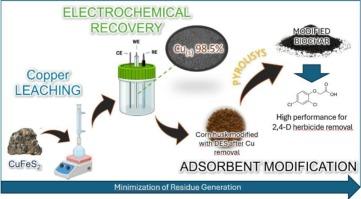从黄铜矿中可持续回收铜:作为绿色浸出介质的共晶溶剂、原位电沉积和吸附剂改性平台:零废物过程的初步尝试
IF 4.8
2区 材料科学
Q1 METALLURGY & METALLURGICAL ENGINEERING
引用次数: 0
摘要
从黄铜矿中提取铜的火法冶金工艺存在能源消耗和有毒气体排放造成的污染等缺点,需要采用更可持续的方法提取铜。本研究提出了一种基于湿法冶金的黄铜矿精矿浸出循环方法,使用由甲磺酸和胆碱盐组成的深共晶溶剂(DES)作为绿色浸出剂,重点是尽量减少废物。通过改变胆碱盐(氯化物、酒石酸盐或柠檬酸二氢盐)中的阴离子、固液比(RS-L分别为0.04和0.02 g g - 1)以及DES含水量(0、10和30%)来评估浸出效率。将黄铜矿浸出的渗滤液就地电沉积铜后,将其残渣与农工生物质废弃物结合,制备了一种高性能吸附剂,用于去除水中介质中的2,4-二氯苯氧乙酸(2,4- d)。以氯化胆碱、甲磺酸和30%的水为原料,在0.04 g g−1的RS-L条件下形成DES,可以从黄铜矿中浸出75%的铜。采用循环伏安法研究了DES渗滤液中溶解铜的氧化还原行为,并采用电沉积法回收了纯度为99%的金属铜。与文献中报道的其他材料相比,该吸附剂具有170 mg g−1的优越2,4- d去除能力。所提出的工艺是一个概念证明,使用DES可以减少从黄铜矿中回收高纯度铜所需的步骤数。这是一种可持续的方法,它整合了材料和能量流,安全处理潜在的有害元素,并通过应用联合循环湿法冶金原理实现零废物开采。本文章由计算机程序翻译,如有差异,请以英文原文为准。

Sustainable copper recovery from chalcopyrite: Eutectic solvent as a green medium for leaching, in situ electrodeposition, and platform for adsorbent modification: Preliminary attempt for a zero-waste process
The pyrometallurgical process for extracting copper from chalcopyrite has disadvantages related to energy consumption and pollution due to toxic gas emissions, necessitating the adoption of more sustainable approaches for copper extraction. This study proposes a circular methodology for hydrometallurgy-based leaching of chalcopyrite concentrate, using deep eutectic solvents (DES) composed of methanesulfonic acid and choline salts as green leaching agents, focusing on waste minimization. Evaluation of leaching efficiency was performed varying the anion in the choline salt (chloride, bitartrate, or dihydrogen citrate), the solid/liquid ratio (RS-L of 0.04 and 0.02 g g−1), and the DES water content (0, 10, and 30 %). After in situ copper electrodeposition directly from the leachate obtained from chalcopyrite leaching, the residue remaining was combined with an agro-industrial biomass waste to prepare a high-performance adsorbent for removing 2,4-dichlorophenoxyacetic acid (2,4-D) from aqueous media. The DES formed with choline chloride, methanesulfonic acid, and 30 % water, used at RS-L of 0.04 g g−1, enabled the leaching of 75 % of the copper from chalcopyrite. The redox behavior of the dissolved copper in the DES leachate was investigated by cyclic voltammetry, and copper was recovered by electrodeposition as metallic copper with purity of 99 %. The adsorbent exhibited a superior 2,4-D removal capacity of 170 mg g−1, compared to other materials reported in the literature. The proposed process is a proof-of-concept that the use of DES can reduce the number of steps required for recovery of high-purity copper from chalcopyrite. This is a sustainable method that integrates material and energy flows, safely disposes of potentially harmful elements, and achieves zero-waste mining by applying combined circular hydrometallurgy principles.
求助全文
通过发布文献求助,成功后即可免费获取论文全文。
去求助
来源期刊

Hydrometallurgy
工程技术-冶金工程
CiteScore
9.50
自引率
6.40%
发文量
144
审稿时长
3.4 months
期刊介绍:
Hydrometallurgy aims to compile studies on novel processes, process design, chemistry, modelling, control, economics and interfaces between unit operations, and to provide a forum for discussions on case histories and operational difficulties.
Topics covered include: leaching of metal values by chemical reagents or bacterial action at ambient or elevated pressures and temperatures; separation of solids from leach liquors; removal of impurities and recovery of metal values by precipitation, ion exchange, solvent extraction, gaseous reduction, cementation, electro-winning and electro-refining; pre-treatment of ores by roasting or chemical treatments such as halogenation or reduction; recycling of reagents and treatment of effluents.
 求助内容:
求助内容: 应助结果提醒方式:
应助结果提醒方式:


